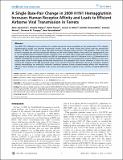| dc.contributor.author | Jayaraman, Akila | |
| dc.contributor.author | Pappas, Claudia | |
| dc.contributor.author | Raman, Rahul | |
| dc.contributor.author | Belser, Jessica A. | |
| dc.contributor.author | Viswanathan, Karthik | |
| dc.contributor.author | Tumpey, Terrence M. | |
| dc.contributor.author | Sasisekharan, Ram | |
| dc.contributor.author | Shriver, Zachary H. | |
| dc.date.accessioned | 2011-08-31T18:43:35Z | |
| dc.date.available | 2011-08-31T18:43:35Z | |
| dc.date.issued | 2011-03 | |
| dc.date.submitted | 2010-11 | |
| dc.identifier.issn | 1932-6203 | |
| dc.identifier.uri | http://hdl.handle.net/1721.1/65575 | |
| dc.description.abstract | The 2009 H1N1 influenza A virus continues to circulate among the human population as the predominant H1N1 subtype. Epidemiological studies and airborne transmission studies using the ferret model have shown that the transmission efficiency of 2009 H1N1 viruses is lower than that of previous seasonal strains and the 1918 pandemic H1N1 strain. We recently correlated this reduced transmission efficiency to the lower binding affinity of the 2009 H1N1 hemagglutinin (HA) to α2→6 sialylated glycan receptors (human receptors). Here we report that a single point mutation (Ile219→Lys; a base pair change) in the glycan receptor-binding site (RBS) of a representative 2009 H1N1 influenza A virus, A/California/04/09 or CA04/09, quantitatively increases its human receptor-binding affinity. The increased human receptor-affinity is in the same range as that of the HA from highly transmissible seasonal and 1918 pandemic H1N1 viruses. Moreover, a 2009 H1N1 virus carrying this mutation in the RBS (generated using reverse genetics) transmits efficiently in ferrets by respiratory droplets thereby reestablishing our previously observed correlation between human receptor-binding affinity and transmission efficiency. These findings are significant in the context of monitoring the evolution of the currently circulating 2009 H1N1 viruses. | en_US |
| dc.language.iso | en_US | |
| dc.publisher | Public Library of Science | en_US |
| dc.relation.isversionof | http://dx.doi.org/10.1371/journal.pone.0017616 | en_US |
| dc.rights | Creative Commons Attribution | en_US |
| dc.rights.uri | http://creativecommons.org/licenses/by/2.5/ | en_US |
| dc.source | PLoS | en_US |
| dc.title | A Single Base-Pair Change in 2009 H1N1 Hemagglutinin Increases Human Receptor Affinity and Leads to Efficient Airborne Viral Transmission in Ferrets | en_US |
| dc.type | Article | en_US |
| dc.identifier.citation | Jayaraman, Akila et al. “A Single Base-Pair Change in 2009 H1N1 Hemagglutinin Increases Human Receptor Affinity and Leads to Efficient Airborne Viral Transmission in Ferrets.” Ed. Elankumaran Subbiah. PLoS ONE 6.3 (2011) : e17616. | en_US |
| dc.contributor.department | Harvard University--MIT Division of Health Sciences and Technology | en_US |
| dc.contributor.department | Massachusetts Institute of Technology. Department of Biological Engineering | en_US |
| dc.contributor.department | Singapore-MIT Alliance in Research and Technology (SMART) | en_US |
| dc.contributor.department | Koch Institute for Integrative Cancer Research at MIT | en_US |
| dc.contributor.approver | Sasisekharan, Ram | |
| dc.contributor.mitauthor | Sasisekharan, Ram | |
| dc.contributor.mitauthor | Jayaraman, Akila | |
| dc.contributor.mitauthor | Raman, Rahul | |
| dc.contributor.mitauthor | Viswanathan, Karthik | |
| dc.contributor.mitauthor | Shriver, Zachary | |
| dc.relation.journal | PLoS ONE | en_US |
| dc.eprint.version | Final published version | en_US |
| dc.type.uri | http://purl.org/eprint/type/JournalArticle | en_US |
| eprint.status | http://purl.org/eprint/status/PeerReviewed | en_US |
| dspace.orderedauthors | Jayaraman, Akila; Pappas, Claudia; Raman, Rahul; Belser, Jessica A.; Viswanathan, Karthik; Shriver, Zachary; Tumpey, Terrence M.; Sasisekharan, Ram | en |
| dc.identifier.orcid | https://orcid.org/0000-0002-1288-9965 | |
| dc.identifier.orcid | https://orcid.org/0000-0001-9344-0205 | |
| dc.identifier.orcid | https://orcid.org/0000-0002-2085-7840 | |
| mit.license | PUBLISHER_CC | en_US |
| mit.metadata.status | Complete | |
